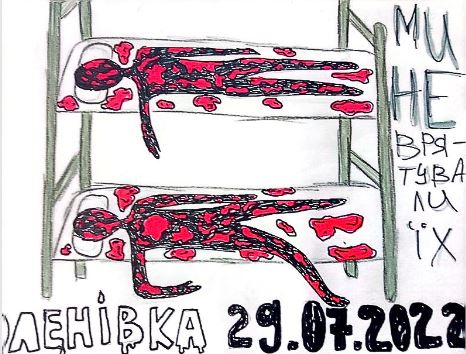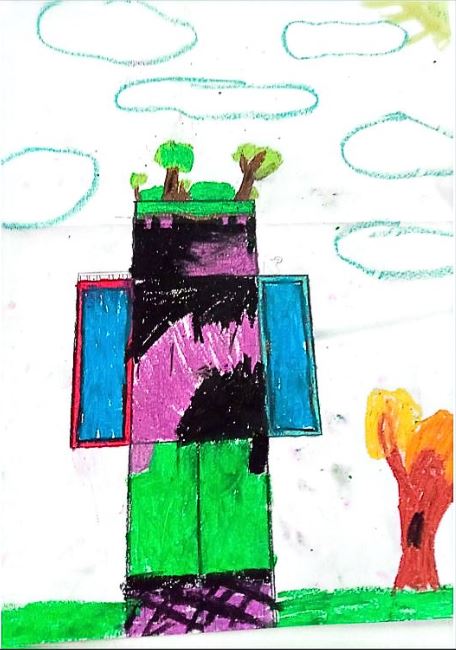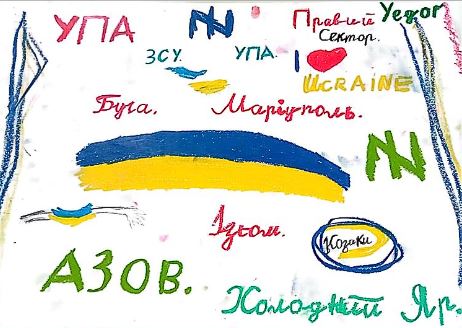Sezione Locale della Società Psicoanalitica Italiana
Sezione Locale della Società Psicoanalitica Italiana
Patrizia Montagner
(Portogruaro, Venice), Member of the Società Psicoanalitica Italiana, Centro Veneto di Psicoanalisi
This paper stems from some observations I made during the work with Ukrainian children and teenagers refugees. It has the characteristic of being a work in progress and of being updated as of today, that is, a little more than a year after the beginning of the war in Ukraine. We are aware that much is still to be observed and understood and that there may be considerable changes in the future compared to the present situation, as the evolution of migration issues and the condition of refugees is greatly affected by the social, political and humanitarian situation in which they are living.
One of the most terrible consequences of war is the migration of people living in war zones.
When war broke out in Ukraine, many Ukrainians had to flee their country; Europe took in millions, at least 5 million, and Italy in a short time made room for about 200,000 of them.
The welcome they received was particularly benevolent, and housing and accommodations were quickly arranged. This tells us how much the people of Italy were touched by the events and got busy, along with the Italian and European governments.
Why this kind of reception? I think for several reasons.
First of all, they are European citizens like us, and then they are white. But that is not enough. My idea is that there has been a great identification with these refugees, whom we have felt close to us, and above all we have feared and fear to be, like them, victims of the war if it spreads. We fear that we will have to flee like them. The war in Europe surprised us and perhaps disappointed us in our expectations that we would be able to guarantee Europe and ourselves a last lasting peace. (Freud 1915; Winnicott 1986).
We see that after a year war and refugees have unfortunately become almost “habitual” and no longer solicit the same participation that we saw in the first months, confirming the mechanism highlighted by Amati Sas that we adapt to “anything” (Amati Sas, 2020).
Real help was given to the refugees. An help that was overall well-organized and quick, but which does not, however, entail the possibility of as much help with the mental problems they present. Indeed, perhaps the difficulties here are paradoxically greater than with other migrants. Ukrainian refugees are also often very traumatized people, but it is difficult to give support in this regard. Trauma is not recognized, and even those who display obvious symptoms such as sleep disturbances, closure or flashbacks, often do not want to be helped. They play it down.
More than two-thirds of the refugees have the intention to return home, and they believe that the suffering is momentary, not deserving of any intervention.
THE desire to go back means that there is a very little – if any – desire to fit into our social reality. There is no desire in them, if not in some, to bond with other people who are not from their country, they do not wish to learn our language, which is considered “useless” unlike others such as English that can be useful, they do not want to find a job. We should add that most of the families that have arrived are composed of mothers, children and female relatives, there are no fathers, possibly grandfathers, and there are no children over 18 years old. In these families we have seen the creation of major regressions and accentuated dependence on female figures, especially mothers. Certainly, this also has a lot to do with the family reality and the psychic situation of the refugees before displacement, however I think it is a significant condition. Families without fathers, distant and traumatized, in which it is difficult to feel an authority that assigns children and parents their respective roles. Oedipal conflicts that are powerfully reactivated.
To the present date some have returned home permanently, but most of them, although they made a quick return to see family and places again, have since returned to Italy. What does it mean for children and adolescents being here “momentarily,”? What are the implications of the sudden flight from home and what are those of this coming and going with the uncertainty that it follows?
I think one has to consider the fact that the experience of the Ukrainian refugees is that of having been forced to leave because their country was invaded with the aim of making it for all intents and purposes a Russian territory. This has understandably generated in them a deep anguish of losing their social identity and having to give up the specific characteristics that come with it: language, traditions, culture.
One of the first things we tried to do for them was to send them to school in our country, with the aim of getting them back on the path of interrupted learning and also encouraging new participation among peer groups.
The Italian school went to great lengths to include the kids, and the placements, though with much difficulty, took place last school year through June. Now in their second year, the vast majority of the refugee follow their home class lessons in Ukraine online, being in front of their cell phones practically all day. This has the function for them to maintain and safeguard their connection with their homeland, culture, language, etc. However, this actually leads to a condition of closure, loneliness and non-participation in social activities in the place where they now live.
We have organized[1] and we participate in initiatives aimed at providing psychic support to those who are refugees from Ukraine, and we have built a complex project of support that covers caregivers, mothers and children, and another also directed at schools, and children and families in obvious difficulty.
What is especially troubling is the condition of silence about their suffering that Ukrainian teenagers experience.
During one of the group observations organized with them, one said, “Every day is the same.” Some of them have been included in sports activities and this is the only interesting experience of the week. Of particular concern is the fact that they are always connected to their cell phones on which they search for pictures and videos of what is happening in their home country. All this makes them continually exposed to highly traumatic visual content that they are unable to process, which who knows if they talk about in their families. It is important for them to have this contact; through it they participate in what is happening far away from them, perhaps indirectly experience the lives of the heroes who are defending them, and perhaps feel less guilty about fleeing.
The disturbing aspect is the amount of hatred that these children are growing within them toward the Russians. It is fully motivated by the events of the war. However, it is a new element; Ukrainians and Russians were culturally close peoples. Many Ukrainian teenagers, especially from the eastern regions, can speak Russian. What fate will this hatred have in the future? What deep cleavages is it causing? Will it be projected and maintained outside by increasing the conflict? Will it occur that a mechanism of identification with the aggressor will be activated? Will it be introjected causing depressive and melancholic experiences?
Hate has the function at this stage of sustaining social identity. For an adolescent, engaged in a crucial stage of the subjectification process, it constitutes an important element of his or her identity (Nicholas, Novelletto, Winnicott).
We observe that many of them are in great pain. They all present symptoms of a post traumatic stress condition (Bolheber, Elton et al, Garland). We know that in traumatic situations the speed with which it is talked about makes a difference. One wonders what is involved in the fact that no one seems to want to consider the problem. No doubt the denial and splitting defense are in place. How well do they really work?
These are defenses that imply an accentuation of closure and loneliness, at a stage of psychic life when participation and sharing with peers acquire a fundamental value.
During observations with them, I suggested drawing and painting. These are activities that engage them; by painting they talk. They tell about themselves, but without feeling sick or problematic. They manage to show a little of their suffering. Although they are not interested in learning, nevertheless in the group they help each other with language, they try to help each other out to communicate with me a little bit in Italian, a little bit in English and a little bit with the translator, to make themselves understood. I think the problem of not betraying their origins, which confronts all migrants with the difficult choice, never quite made, whether to integrate or not, represents an unbearable inner reality in them. Staying well here is experienced as a betrayal of their country, their roots, their comrades there.
The need is to strengthen the connection with that national reality, emphasizing all the tragic news coming from there. Everyone often draws their flag, and they use the colors yellow and blue very frequently.
However, the need to communicate, when they are enabled to do so, emerges. Communicate, not talk. By drawing, the psychic weight of the word is lightened; it is used “only” to describe the image (Di Benedetto).
They thus allow me to understand something about them and allow themselves to express something of their pain.
Here now are two short vignettes, testifying to the depth of the trauma, the suffering they experience and that continues to torture them.
The first is about a 14-year-old girl. I propose to draw; someone in the group does it willingly, someone else waits a little while to get going, she tells me she doesn’t want to draw, and adds that she only draws things from the war. I tell her it’s okay, she can draw whatever she likes. She doesn’t want to draw here. She runs off to her room and comes back with some sheets full of figures, other pictures of her have them in her cell phone.
—
[1] As members of the PER (European Psychoanalysts for Refugees) Group of CVP and also other local Associations.
The images in this article are also subject to the Creative Commons licence. In order to reproduce them, the source, i.e. this article, must be properly quoted.
These are images of tragic incidents in Ukraine that he has heard about. He says that he stands in front of the screen and watches what happens and then draws.

Terrifying images in which fear, horror and destruction are depicted with extraordinary skill.
He tells me he thinks about it all the time.
These images seem analogous to the recurrent dreams and flashbacks so frequent in those who have suffered trauma (Freud 1920). An attempt that her psyche is making to master the trauma, to take an active role in the face of it, to bind together elements that need connection and meaning. I see how important it is for the young designer that I pay attention to her production and comment on the pain and tragedy she is experiencing. How important it is also that I accept that the drawings are her productions from a time other than this one, they testify to what she experiences when she is alone.
These are images that speak for themselves, screaming horror.
There are two more drawings of a 12-year-old boy who speaks good English. He is always sleepy. The others in the group mock him a little for this. He actually seems very, too bright to me. But perhaps his being sleepy represents a strenuous defense against a reality, the present one, so unacceptable to him. He gladly agrees to draw, though. In the first meeting he draws a house; it is the one in a Minecraft video game.

(In Minecraft, players can freely explore a 3D world made up of blocks, go in search of raw minerals, make tools and various objects, and build structures. Depending on the game mode, it is possible to fight entities.) It is made of pieces put together. It looks unlivable to me. In the second drawing he makes this kind of map. With Ukrainian cities where attacks and violence by the Russians have taken place.

And then he picks up a map he has on the first page of his journal and starts erasing some countries with white-out. I ask what he does. He says, “It’s where the Russians are now.”
I remain speechless. The scene has frozen my mind.
Slowly I was able to do some thinking about this. To consider that it was first of all a matter of space and place. That it is necessary to maintain a container to exist and to grow.
This preadolescent is beginning to reflect on his own identity. Thus he shows how, in order to begin this process, he feels he must put pieces together and place them in a place. The war has broken the container. Then resuming the path means for him to return to refer to and keep alive the place where his growth took place and where his identity has been maintained until now. Eliminate the places where the enemy can potentially destroy it and annihilate the continuity of self.
References
Amati Sas S. 2020 Ambiguità, conformismo e adattamento alla violenza sociale . Franco Angeli. Milano
Bohleber W. L’anima sopraffatta- Quando la realtà diventa traumatica. In Riv.di Psicoan. Anno LXVI n°1 2020
Di Benedetto A. Prima della parola Angeli. Milano 2002
Elton V. e altri Trauma, Flight and Migration Psychoanalytical Perspectives, Routledge 2023
Freud S. (1915). Considerazioni attuali sulla guerra e la morte. O.S.F., VIII.
Freud S. (1920). Al di là del principio di piacere. O.S.F., IX.
Garland C. (A cura di) (2001). Comprendere il trauma. Un approccio psicoanalitico. Milano, Mondadori
Nicolò A.M., Zavattini G.C. (1992). L’adolescente e il suo mondo relazionale. Roma, NIS.
Novelletto A. (1986). Psichiatria Psicoanalitica dell’adolescenza. Roma, Borla.
Winnicott D.W. (1961). Adolescenza. Il dibattersi nella bonaccia. In La famiglia e lo sviluppo dell’individuo. Roma, Armando.
Winnicott D.W. (1968). Il gioco dello scarabocchio, in Esplorazioni psicoanalitiche (1989), a cura di Clare Winnicott, Ray Shepherd e Madeleine Davis, ed. it. a cura di Carla Maria Xella, Milano, Cortina, 1995.
Winnicott D.W. (1971). Gioco e Realtà. Roma, Armando, 1974.
Winnicott D.W. (1986). La libertà. In Dal luogo delle origini. Milano, Cortina, 1990.
Da internet
https://www.minecraft.net/it-it
Condividi questa pagina:
Centro Veneto di Psicoanalisi
Vicolo dei Conti 14
35122 Padova
Tel. 049 659711
P.I. 03323130280